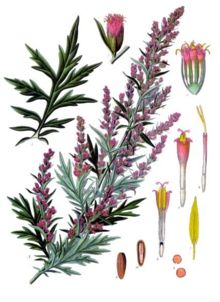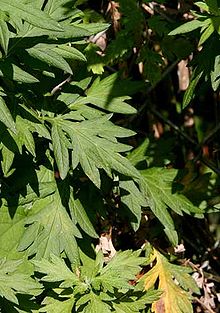- Artemisia vulgaris
-
Mugwort 
Scientific classification Kingdom: Plantae (unranked): Angiosperms (unranked): Eudicots (unranked): Asterids Order: Asterales Family: Asteraceae Subfamily: Asteroideae Tribe: Anthemideae Subtribe: Artemisiinae Genus: Artemisia Species: A. vulgaris Binomial name Artemisia vulgaris
L.Artemisia vulgaris (mugwort or common wormwood) is one of several species in the genus Artemisia which have common names that include the word mugwort. This species is also occasionally known as Felon Herb, Chrysanthemum Weed, Wild Wormwood, Old uncle Henry, Sailor's Tobacco, Naughty Man, Old Man or St. John's Plant (not to be confused with St John's wort).
It is native to temperate Europe, Asia, northern Africa and Alaska and is naturalized in North America,[1] where some consider it an invasive weed. It is a very common plant growing on nitrogenous soils, like weedy and uncultivated areas, such as waste places and roadsides.
It is a tall herbaceous perennial plant growing 1–2 m (rarely 2.5 m) tall, with a woody root. The leaves are 5–20 cm long, dark green, pinnate, with dense white tomentose hairs on the underside. The erect stem often has a red-purplish tinge. The rather small flowers (5 mm long) are radially symmetrical with many yellow or dark red petals. The narrow and numerous capitula (flower heads) spread out in racemose panicles. It flowers from July to September.
A number of species of Lepidoptera (butterflies and moths) feed on the leaves and flowers; see List of Lepidoptera that feed on Artemisia for details.
Contents
Etymology
Mugwort is often said to derive from the word "mug" since it has been used in flavoring drinks at least since the early Iron Age.[2] However, this may be a folk etymology based on coincidental sounds. Other sources say Mugwort is derived from the old Norse muggi, meaning "marsh", and Germanic "wuertz", meaning "root", which refers to its use since ancient times to repel insects, especially moths.[3] The Old English word for mugwort is "mucgwyrt" where "mucg-" could be a variation of the Old English word for midge "mycg". Wort comes from the Old English "wyrt" (root/herb/plant) which is related to the Old High Germany "wurz" (root) and the Old Norse "urt" (plant).[4] Mugwort is called chornobylnik in Ukrainian, and has given its name to the abandoned city of Chernobyl (Chornobyl in Ukrainian). The name chornobyl has an interesting history, meaning "place where mugwort grows" in the related Indo-European languages.[citation needed]
Related species
There are other species in the genus Artemisia called mugwort:
- Artemisia douglasiana – Douglas' Mugwort
- Artemisia glacialis – Alpine Mugwort
- Artemisia norvegica – Norwegian Mugwort
- Artemisia princeps – Japanese Mugwort ("Yomogi")
- Artemisia stelleriana – Hoary Mugwort
- Artemisia verlotiorum – Chinese Mugwort
Uses
Mugwort oil contains thujone, which is toxic in large amounts or under prolonged intake. Thujone is also present in Thuja plicata (western red cedar), from which the name is derived. Mugwort herb contains a very small percentage of oil, so is generally considered safe to use.[5] Pregnant women, though, should avoid consuming large amounts of mugwort. The species has a number of recorded historic uses in food, herbal medicine, and as a smoking herb.
Middle ages
In the Middle Ages, mugwort was used as a magical protective herb. Mugwort was used to repel insects, especially moths, from gardens. Mugwort has also been used from ancient times as a remedy against fatigue and to protect travelers against evil spirits and wild animals. Roman soldiers put mugwort in their sandals to protect their feet against fatigue.[6] Mugwort is one of the nine herbs invoked in the pagan Anglo-Saxon Nine Herbs Charm, recorded in the 10th century in the Lacnunga.[7]
Food
The leaves and buds, best picked shortly before the plant flowers in July to September, were used as a bitter flavoring agent to season fat, meat and fish.
It has also been used to flavor beer before the introduction of or instead of hops.[2][8]
Medicinal
The mugwort plant contains essential oils (such as cineole, or wormwood oil, and thujone), flavonoids, triterpenes, and coumarin derivatives. It was also used as an anthelminthic, so it is sometimes confused with wormwood (Artemisia absinthium). The plant, called nagadamni in Sanskrit, is used in Ayurveda for cardiac complaints as well as feelings of unease, unwellness and general malaise.[9]
In Traditional Japanese Medicine as well as Chinese Medicine, Chinese mugwort (Folium Artemisiae argyi) is used for moxibustion, for a wide variety of health issues. The herb can be placed directly on the skin, attached to acupuncture needles, or rolled into sticks and waved gently over the area to be treated. In all instances, the herb is ignited and releases heat. Not only is it the herb which is believed to have healing properties in this manner, but it is also the heat released from the herb in a precise area that heals. There is significant technique involved when the herb is rolled into tiny pieces the size of a rice grain and lit with an incense stick directly on the skin. The little herbal fire is extinguished just before the lit herb actually touches the skin.
In Traditional Chinese medicine there is a belief that moxibustion of mugwort is effective at increasing the cephalic positioning of fetuses who were in a breech position before the intervention. A Cochrane review in 2005 found that moxibustion may be beneficial in reducing the need for ECV, but stressed a need for well-designed randomised controlled trials to evaluate this usage.[10] Since it also causes uterine contractions, it has been used to cause abortion. A study of 260 Chinese women at 33 weeks of pregnancy demonstrated cephalic version within two weeks in 75% of fetuses carried by patients who were treated with moxibustion, as opposed to 48% in the control group.[11] It has also been shown that acupuncture plus moxibustion slows fetal heart rates while increasing fetal movement.[12] Two recent studies of Italian patients produced conflicting results. In the first, involving 226 patients, there was cephalic presentation at delivery in 54% of women treated between 33 and 35 weeks with acupuncture and moxibustion, vs. 37% in the control group.[13] The second was terminated prematurely because of poor compliance with treatment, but found no difference between moxibustion and control groups.[14]
In rats, Mugwort shows efficacy against trichinellosis.[15]
China
There are several references to the Chinese using mugwort in cuisine. The famous Chinese poet Sū Shì (蘇軾) in the 11th century mentioned it in one of his poems. There are even older poems and songs that can be tracked back to 3 BC. Mainly it was called lóuhāo (蒌蒿) or Ai Tsao (艾草 zh:艾草) in Mandarin. Mugwort can be prepared as a cold dish or can be stir-fried with fresh or smoked meat. The Hakka Taiwanese also use it to make chhú-khak-ké (鼠麹粿, 草仔粿).
Mugwort is used in the practice of traditional Chinese medicine in a pulverized and aged form called moxa.
Germany
In Germany, known as Beifuß, it is mainly used to season goose, especially the roast goose traditionally eaten for Christmas. From the German, ancient use of a sprig of mugwort inserted into the goose cavity, comes the saying "goosed" or "is goosed".[citation needed]
Korea
In North-Korea en South-Korea mugwort, ssuk (쑥) is being used in soups and salads. A traditional soup containing mugwort and clams is Ssukguk (쑥국) this soup is made in spring from the young plants just before they bloom. Another dish is named Ssukbeomul.(쑥버물) The mugwort is mixed with rice flour, sugar, salt and water and is then steamed. furthermore it is a common ingredient in rice cakes, teas, soups, and pancakes. Known as a blood cleanser, it is believed to have different medicinal properties depending on the region it is collected. In some regions, mugwort thins the blood, while in another region, it is proposed to have hallucinogenic properties, causing some to pass out from direct skin contact (dermal absorption) with the active chemicals. For this reason, some Koreans also wear a silk sleeve when picking mugwort plants.
Japan
Mugwort or yomogi is used in a number of Japanese dishes, including yōkan, a dessert, or kusa mochi, also known as yomogi mochi.
Mugwort rice cakes, or kusa mochi are used for Japanese sweets called Daifuku (which literally translated means 'great luck'). To make these take a small amount of mochi and stuff it or wrap it round a filling of fruit or sweetened azuki (red bean) paste. Traditional Daifuku can be pale green, white or pale pink and are covered in a fine layer of potato starch to prevent sticking.
Ingredients for kusa mochi[16]: Whole-grain sweet brown rice and Japanese mugwort (yomogi) herb.
Mugwort is a vital ingredient of kusa mochi (rice cake with mugwort) and hishi mochi (lozenge rice cake) which is served at the Doll Festival in March. In addition, the fuzz on the underside of the mugwort leaves is gathered and used in moxibustion. In some regions in Japan,[17] there is an ancient custom of hanging yomogi and iris leaves together outside homes in order to keep evil spirits away. It is said that evil spirits dislike their smell. The juice is said to be effective at stopping bleeding, lowering fevers and purging the stomach of impurities. It can also be boiled and taken to relieve colds and coughs.
Allergen
Mugwort pollen is one of the main sources of hay fever and allergic asthma, in North Europe, North America and in parts of Asia.[18][19] Mugwort pollen generally travels less than 2,000 meters.[20] The highest concentration of mugwort pollen is generally found between 9 and 11 am. The Finnish allergy association recommends tearing as method of eradicating mugwort.[20] Tearing mugwort is known to lessen the effect of the allergy, since the pollen flies only short distance[20]].
Cooking is known to decrease the allergenicity of mugwort.
References
- ^ USDA PLANTS Database, "Profile for Artemisia vulgaris," http://plants.usda.gov/java/profile?symbol=ARVU .
- ^ a b Edwards, Lin (January 17, 2011). "Brewery from 500 BC reveals its secrets". Archeology & Fossils. Physics News. doi:10.1007/s12520-010-0049-5. http://www.physorg.com/news/2011-01-brewery-bc-reveals-secrets.html. Retrieved January 17, 2011.
- ^ Lust, J. (2005) The Herb Book 604.
- ^ Merriam Webster Dictionary
- ^ http://www.henriettesherbal.com/archives/best/1996/mugwort.html
- ^ Wright, Colin, Ed. (2002). Artemisia. London; New York: Taylor & Francis. pp. 144. ISBN 0-415-27212-2. http://books.google.com/?id=t0MtnKDvLLwC&pg=PA144&lpg=PA144&dq=roman+soldiers+mugwort.
- ^ Stephen Pollington "Leechcraft: Early English Charms, Plantlore and Healing"
- ^ Llewellyn's 2010 Herbal Almanac by Llewellyn
- ^ Ramawat, K. G., Ed. (2004). Biotechnology of Medicinal Plants: Vitalizer and Therapeutic Enfield, New Hampshire: Science Publishers, Inc. 5.
- ^ Meaghan E Coyle, Caroline A Smith and Brian Peat (16 February 2005). "Cephalic version by moxibustion for breech presentation". http://mrw.interscience.wiley.com/cochrane/clsysrev/articles/CD003928/frame.html. Retrieved 2010-01-21.
- ^ Cardini, F., and W. X. Huang. JAMA 280(18): 1580-1584, November 1998
- ^ Neri, I., et al. Journal of the Society for Gynecological Investigation 9(3): 158-162, May–June 2002
- ^ Neri, I., et al. Journal of Maternal-Fetal and Neonatal Medicine 15(4): 247-252
- ^ Cardini, F., et al. BJOG 112(6): 743-747, June 2005
- ^ Caner A, Döşkaya M, Değirmenci A, et al. (May 2008). "Comparison of the effects of Artemisia vulgaris and Artemisia absinthium growing in western Anatolia against trichinellosis (Trichinella spiralis) in rats". Exp. Parasitol. 119 (1): 173–9. doi:10.1016/j.exppara.2008.01.012. PMID 18325496.
- ^ Mitoku http://www.goodnessdirect.co.uk/cgi-local/frameset/detail/415726_Mitoku_Brown_Rice_Mochi_With_Mugwort___250g.html
- ^ http://www.shejapan.com/jtyeholder/jtye/living/wagashi/wagashi3.html
- ^ http://www.fasebj.org/cgi/content/full/17/1/106
- ^ http://www.weather.com/outlook/health/allergies/common/allergens/AK-allergen-192?from=allergy_allergenstate_more
- ^ a b c http://www.allergia.com/index.phtml?s=849
External links
Categories:- Artemisia
- Asteraceae
- Abortifacients
- Herbs
- Medicinal plants
- Flora of Alabama
- Flora of Michigan
- Witchcraft
Wikimedia Foundation. 2010.


